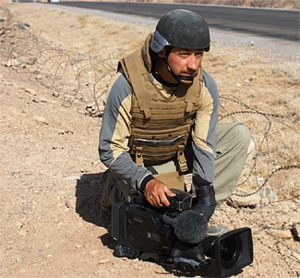Sony XDCAM is Real Trooper

Thierry Humeau
WASHINGTON
I've used Sony's XDCAM HD optical camcorders in many challenging environments, and the latest test under fire was during a six-week shoot in Southern Helmand, Afghanistan. I was there as part of National Geographic Television production team embedded with the Second Marines Expeditionary Brigade.
We were shooting scenes for "Camp Leatherneck," which aired as part of the National Geographic Explorer series. The program's goal was to go beyond newspaper and TV news accounts and document what it's really like to serve on the front lines of this conflict.
The shoot amounted to total immersion in the war in Afghanistan: the heat, violence, dust, misery, and the day-to-day mission of the U.S. Marines.
We were trying to achieve a very specific look in terms of style, feel and, of course, image quality. To complement our use of the XDCAM HD PDW-F800 camcorder, we also used Sony's smaller XDCAM EX (PMW-EX1) solid-state memory camcorder.
I used the F800 for capturing the core of the show whenever portability and environmental conditions were appropriate. We knew ahead of the as-signment that we would have to go "outside the wire," and for these difficult, and often perilous missions. I needed a more compact and agile camera with an image quality that would mix well with that of the F800. The PMW-EX1 was a natural choice, as it's the most compact 1/2-inch HD imager camera available on the market, and provides excellent picture quality with low power consumption.
COPES WITH MULTIPLE LIGHTING ENVIRONMENTS
On documentary shoots, for the "run and gun" type situations, I'm very reluctant to use any additional light, as I like to preserve the look, drama and feel of low light environments. Both the PMW-EX1 and PDW-F800 offer excellent performance in such conditions and even with 9 or 12 dB of gain, noise is minimal. We were often shooting in varying light conditions—day, night, interior, exterior, bright sunlight, low light—and despite these extremes, both cameras performed flawlessly.
War zones are often demanding environments for people and equipment. The Helmand province in Southern Afghanistan is a very harsh environment of desert lands where temperatures can reach well over 120 F degrees in the summer. A thin crust covers a thick layer of very fine "moon dust" that—once broken by footsteps or vehicle tracks—flies all over the place. In my 30 years of assignments, I'd never experienced such a hostile working environ-ment. I knew that aside from road bombs and insurgent attacks, dust and heat would be my other enemies.
'MOON DUST' DOESN'T STOP THEM
We'd used the XDCAM HD and XDCAM EX cameras on previous projects and fully trusted them for this new adventure. Early in my shooting, I tried using rain covers to protect the cameras from dust. These weren't very practical and I soon gave up on them, as the camera was still covered with dust.
Even under these conditions, I'm pleased to report that in the course of five weeks and 50 hours of shooting, both cameras held up well. I had no failures or downtime to report and never had to unpack the backup camera.
Thierry Humeau is an award winning DP and owner of Télécam Film. He may be contacted atthumeau@telecamfilms.com.
For additional information, contact Sony Electronics at 201-930-1000 or visitwww.sony.com.
Get the TV Tech Newsletter
The professional video industry's #1 source for news, trends and product and tech information. Sign up below.
